- 1移动开发最新面试就是你来我往,互相了解!,2024年最新2024最新Android面试笔试题目分享_移动it岗位面试
- 2Github网站进入及注册_github whoa there
- 3将Stanford CoreNLP的解析结果构造为json格式_nlp库是json格式吗
- 4如何json文件中读出和写入数据_json文件输入一个信息从而带出其他信息
- 5武装部三维电子沙盘系统设计说明_触摸式 三维电子沙盘系统 方案设计
- 6Simplify the Usage of Lexicon in Chinese NER跑论文代码遇坑及解决方法
- 7uniapp使用uni.request传递formData格式时报错_request:fail parameter `data`. expected object, st
- 8zookeeper分布式锁
- 9零投入,高回报:Llama3带你进入私有AI知识库时代_llama3本地知识库
- 10tcp慢开始(Slow-Start)、拥塞避免(Congestion Avoidance)、快重传(Fast Retransmit)和快恢复(Fast Recovery)_tcp slow start
C语言——内存管理_c语言内存管理
赞
踩
C语言目录:
9.1 进程空间
程序(静态):经编译后的可执行文件可以被多次执行
进程(动态):程序在内存中的运行状态为进程
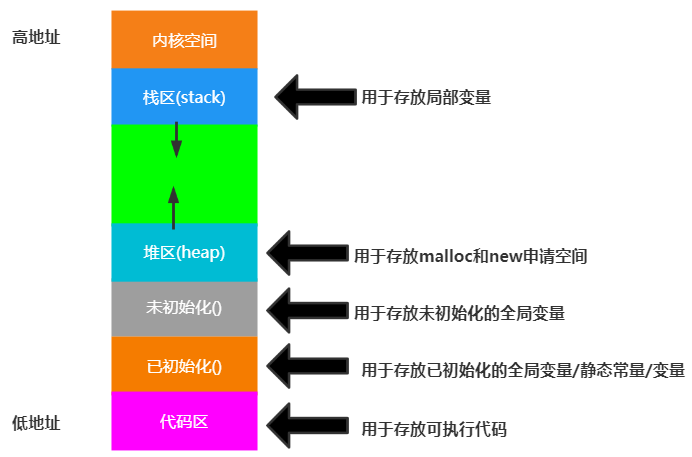
9.1.1 栈内存(stack)
栈中存放任意类型变量,但必须是 auto 类型修饰符的局部变量
随用随开,用完即销
内存的分配和销毁由系统自动完成,不需要人工干预
- 栈内存的分配:从高地址到低地址,为变量分配的内容由
数据类型和空间首地址标记
栈有最大存储空间限制,超出则引起栈溢出
- 如局部变量过多,过大或递归层数太多
#include <stdio.h>
int main(){
int a = 1;
int b = 2;
printf("&a = %p\n", &a); // &a = 0ABC0FFC
printf("&b = %p\n", &b); // &b = 0ABC0FF8
return 0;
}
- 1
- 2
- 3
- 4
- 5
- 6
- 7
- 8
- 9
- 10
- 11
9.1.2 堆内存(heap)
堆内存可以存放任意类型的数据,但需要自己申请与释放
int *p = (int *)malloc(sizeof(int)*1024*1024);
//不一定会崩溃
- 1
- 2
连续两次申请的内存可能不连续,但一定是从小地址开始分配内存
#include <stdio.h>
#include <stdlib.h>
int main(){
int *p1 = (int *)malloc(4);
*p1 = 1;
int *p2 = (int *)malloc(4);
*p2 = 2;
printf("p1 = %p\n", p1); //p1 = 00000227639268C0
printf("p2 = %p\n", p2); //p2 = 0000022763926900
return 0;
}
- 1
- 2
- 3
- 4
- 5
- 6
- 7
- 8
- 9
- 10
- 11
- 12
- 13
- 14
9.2 变量内存分析
9.2.1 变量存储过程
一个变量所占用的存储空间,和 定义变量时声明的类型 以及 编译环境 有关
| 类型 | 32位编译器 | 64位编译器 |
|---|---|---|
| char | 1 | 1 |
| int | 4 | 4 |
| float | 4 | 4 |
| double | 8 | 8 |
| short | 2 | 2 |
| long | 4 | 8 |
| long long | 8 | 8 |
| void* | 4 | 8 |
a. 变量存储的过程
- 根据定义变量时声明的
变量类型和当前编译环境确定需要开辟多大存储空间 - 在内存中开辟一块存储空间,开辟时从内存地址大的开始开辟,将最小的地址返回给变量
- 将数据保存到已经开辟好的内存空间内
变量名:变量的首地址,是变量所占存储空间字节地址(最小的那个地址 )
小端模式:数据的高字节高地址
9.2.2 内存读写操作
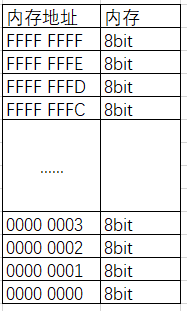
CPU在运行时要明确三件事:
-
存储单元的地址(地址信息)
通过地址总线找到存储单元的地址
-
对部件的操作(读或写,控制信息)
通过控制总线发出内存读写指令
-
数据(数据信息)
通过数据总线传输需要读写的数据
a. 写入过程
- CPU 通过地址线将找到地址为 FFFFFFFC 的内存空间
- CPU 通过控制线发出内存写入命令,选中存储器芯片,并通知它,要其写入数据
- CPU 通过数据线将数据 12 送入内存 FFFFFFFC 单元中
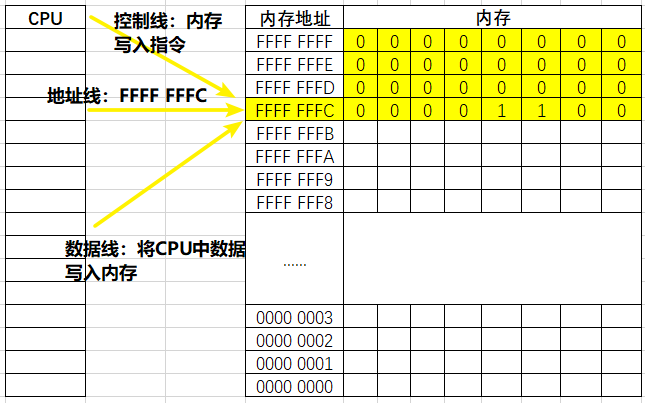
b. 读入过程
- CPU 通过地址线将找到地址为 FFFF FFFC 的内存
- CPU 通过控制线发出内存读取命令,选中存储器芯片,并通知它,将要从中读取数据
- 存储器将 FFFFFFFC 号单元中的数据 12 通过数据线送入 CPU寄存器中
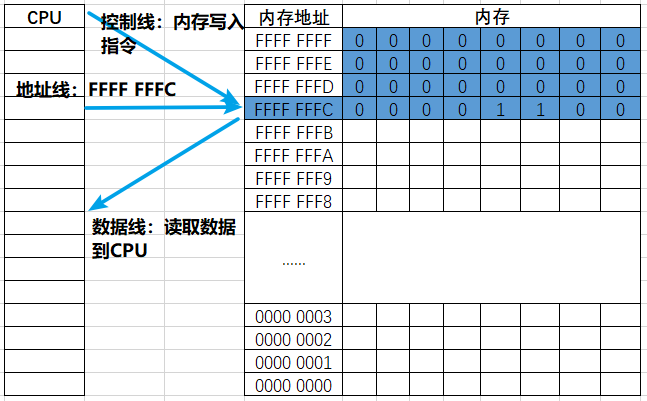
9.3 数据存储区
执行C语言程序,可用的存储区有
-
程序区
-
静态存储区:编译时分配内存;包括
static,extern -
动态存储区:运行时分配内存;包括
static,auto
9.3.1 static
静态局部变量
- 仅在本函数中使用,调用后不清零
- 只能赋一次初值,若不初始化 自动赋0或空字符
- 可使用静态局部变量跟踪调用次数
静态全局变量
- 仅限在定义的文件中使用,可使不同源文件中的静态全局变量独立
9.3.2 extern
在函数外部引用变量使用 extern ,扩充已定义的全局变量作用域
一个C语言程序包含多个源程序,若使用同一外部变量,在一个源文件中定义,在另一个中用 extern 说明是外部变量。引用外部函数时,被引用函数需添加 extern
9.4 动态分配内存
stdlib.h
9.4.1 malloc
void *malloc(size_t size); :在内存中申请一块连续的堆内存空间并返回,所申请的空间并未初始化
-
size :表示要申请的字符数
-
返回值:
成功,返回非空指针,指向申请的空间
失败,返回
NULL
初始化方法:memset(指针, 初始值, 待初始化字节数) 字节初始化
#include <stdio.h>
#include <stdlib.h>
int main(){
int *p = (int *)malloc(sizeof(int));
printf("p = %d\n", *p); // 垃圾值
memset(p, 0, sizeof(int)); // 初始化为0
printf("p = %d\n", *p);
return 0;
}
- 1
- 2
- 3
- 4
- 5
- 6
- 7
- 8
- 9
- 10
- 11
- 12
9.4.2 free
void free(void *p); : 释放通过 malloc() 申请的堆内存空间,所以 malloc() 和 free() 总是成对出现
#include <stdio.h>
#include <stdlib.h>
int main(){
int *p = (int *)malloc(sizeof(int));
printf("p = %d\n", *p); // 垃圾值
memset(p, 0, sizeof(int)); // 初始化为0
printf("p = %d\n", *p);
free(p);
return 0;
}
- 1
- 2
- 3
- 4
- 5
- 6
- 7
- 8
- 9
- 10
- 11
- 12
- 13
- 14
9.4.3 calloc
void *calloc(size_t n,size_t size); :在堆内存中申请 n 块长度为 size 的空间,申请的空间自动初始化为0
- 成功,返回非空指针指向申请的空间
- 失败,返回
NULL
#include <stdio.h> #include <stdlib.h> int main(){ // 申请3块4个字节的存储空间 int *p = calloc(3, sizeof(int)); p[0] = 1; p[1] = 3; p[2] = 5; printf("p[0] = %d\n", p[0]); printf("p[1] = %d\n", p[1]); printf("p[2] = %d\n", p[2]); free(p); return 0; }
- 1
- 2
- 3
- 4
- 5
- 6
- 7
- 8
- 9
- 10
- 11
- 12
- 13
- 14
- 15
- 16
- 17
- 18
9.4.4 realloc
void *realloc(void *p,size_t size); :扩充或缩小原有内存的大小
-
参数
p:表示待扩容的空间指针size:表示扩容后内存的大小 -
返回
成功:返回非空指针指向申请的空间
失败:返回
NULL
注意:
-
当
p == NULL时,realloc(NULL,sizeof(int))等同于malloc(sizeof(int)) -
返回的指针,可能与
p原本的值相同,也可能不同相同:则原空间后后续空间充足
不同:原空间后续内存空间不足,重新申请新的连续空间后,将元数据拷贝到新空间,原有空间会被自动释放
#include <stdio.h> #include <stdlib.h> int main(){ // 申请4个字节存储空间 int *p = malloc(sizeof(int)); printf("p = %p\n", p); //扩容 p = realloc(p, sizeof(int) * 2); printf("p = %p\n", p); //使用申请好的空间 *p = 666; printf("*p = %d\n", *p); // 释放空间 free(p); return 0; }
- 1
- 2
- 3
- 4
- 5
- 6
- 7
- 8
- 9
- 10
- 11
- 12
- 13
- 14
- 15
- 16
- 17
- 18
- 19
- 20
9.4.5 应用——动态链表
a. 链表与静态链表
链表:将零碎的内存空间组织为一组可用的内存空间
- 使用
malloc申请内存空间时,若没有足够大的连续内存空间,则申请失败

静态链表:链表的长度固定,链表的结点固定
# include<stdio.h> # include<stdlib.h> //链表结点 typedef struct node{ int data; struct node *next; }Node; int main(){ Node a,b,c; Node *head = &a; a.data = 1; b.data = 2; c.data = 3; a.next = &b; b.next = &c; c.next = NULL; while(head != NULL){ int cur = head->data; printf("%d\n",cur); head = head->next; } return 0; }
- 1
- 2
- 3
- 4
- 5
- 6
- 7
- 8
- 9
- 10
- 11
- 12
- 13
- 14
- 15
- 16
- 17
- 18
- 19
- 20
- 21
- 22
- 23
- 24
- 25
- 26
- 27
- 28

空链表
头指针带了一个空链表结点,空链表结点中的 next 指向 NULL
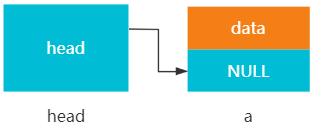
静态链表数据存储在栈上,而栈的存储空间有限。所以要实现链表存储空间的动态分配,需要申请堆里的存储空间
b. 动态链表的创建
头插法
涉及数据结构的线性表,可自行查看:https://auspicetian.life/posts/3975030669/
# include<stdio.h> # include<stdlib.h> //定义结点 typedef struct node { int data; struct node *next; }Node; //创建链表 Node *createList(); //按顺序打印链表中数据 void printNodeList(); int main(){ Node *head = createList(); printNodeList(); return 0; } Node *createList(){ //创建头结点 Node *head = (Node *)malloc(sizeof(Node)); if(head == NULL) return Null; head->next = NULL; //从键盘接收数据 //-1表示输入结束 printf("请逆序输入结点数据:\n"); int data; scanf("%d",&data); while(data != -1){ //创建新结点 Node *cur = (Node *)malloc(sizeof(Node)); cur->data = data; cur->next = head->next; head->next = cur; printf("请逆序输入结点数据:\n"); scanf("%d",&data); } return head; } void printNodeList(Node *node){ Node *head = node->next; while(head != NULL){ int data = head->data; printf("%d\n",data); head = head->next; } }
- 1
- 2
- 3
- 4
- 5
- 6
- 7
- 8
- 9
- 10
- 11
- 12
- 13
- 14
- 15
- 16
- 17
- 18
- 19
- 20
- 21
- 22
- 23
- 24
- 25
- 26
- 27
- 28
- 29
- 30
- 31
- 32
- 33
- 34
- 35
- 36
- 37
- 38
- 39
- 40
- 41
- 42
- 43
- 44
- 45
- 46
- 47
- 48
- 49
- 50
- 51
- 52
- 53
- 54
- 55
- 56
- 57
尾插法
# include<stdio.h> # include<stdlib.h> //定义结点 typedef struct node { int data; struct node *next; }Node; //创建链表 Node *createList(); //按顺序打印链表中数据 void printNodeList(); int main(){ Node *head = createList(); printNodeList(); return 0; } Node *createList(){ Node *head = (Node *)malloc(sizeof(Node)); if(head == NULL) return NULL; head->next = NULL; //从键盘接收数据 //-1表示输入结束 printf("请顺序输入结点数据:\n"); int data; scanf("%d",&data); Node *pre = head; while(data != -1){ Node *cur = (Node *)malloc(sizeof(Node)); cur->data = data; pre->next = cur; cur->next = NULL; pre = cur; scanf("%d",&data); return head; } } void printNodeList(Node *node){ Node *head = node->next; while(head != NULL){ int data = head->data; printf("%d\n",data); head = head->next; } }
- 1
- 2
- 3
- 4
- 5
- 6
- 7
- 8
- 9
- 10
- 11
- 12
- 13
- 14
- 15
- 16
- 17
- 18
- 19
- 20
- 21
- 22
- 23
- 24
- 25
- 26
- 27
- 28
- 29
- 30
- 31
- 32
- 33
- 34
- 35
- 36
- 37
- 38
- 39
- 40
- 41
- 42
- 43
- 44
- 45
- 46
- 47
- 48
- 49
- 50
- 51
- 52
- 53
- 54
- 55
- 56
c. 插入
void preInsertNode(Node *head,int data){ Node *cur = (Node *)malloc(sizeof(Node)); cur->data = data; cur->next = head->next; head->next = cur; } void tailInsertNode(Node *head,int data){ Node *pre = head; while(pre != NULL && pre->next != NULL) pre = pre->next; Node *cur = (Node *)malloc(sizeof(Node)); cur->data = data; cur->next = NULL; pre->next = cur; }
- 1
- 2
- 3
- 4
- 5
- 6
- 7
- 8
- 9
- 10
- 11
- 12
- 13
- 14
- 15
- 16
- 17
- 18
- 19
- 20
d. 销毁
void destoryList(Node *head){
Node *cur = NULL;
while(head != NULL){
cur = head->next;
free(head);
head = cur;
}
}
- 1
- 2
- 3
- 4
- 5
- 6
- 7
- 8
- 9
- 10




